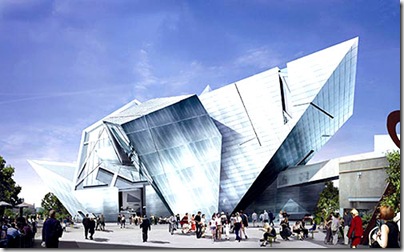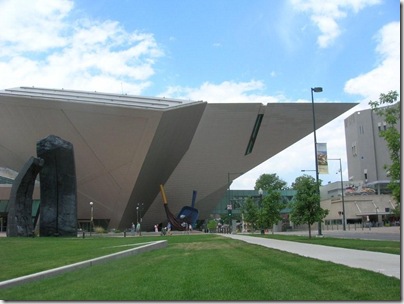The Denver Art Museum is located in the heart of Downtown Denver next to the downtown branch of the Denver Public Library and just a block from the Denver City and County Building, the Colorado State Capital, and Civic Center Park. The museum is occasionally referred to in print as DAM, though never in spoken conversation. It houses several permanent art collections as well as touring or temporary exhibits.
Denver’s art museum has a large collection of Western art, as well as African art, Pacific or Oceanic art, and a respectable modern art collection as well. While the museum cannot compare to the large museums in New York or California, it does have much to offer those interested in art. For those looking for "brand name" or "bit hit" paintings from well known artists such as Monet, Picasso, and Rembrandt, there are a few, but not huge collections, and virtually none that you would recognize from the poster shop in the local mall.
The museum’s contemporary art collection is both worthy and fun. It is bit more accessible than other modern art collections around the country and provides plenty of eye candy as well as the requisite number of "is that really art" pieces.
Denver Art Museum Hours and Prices
The art museum is closed on Mondays, which confuses plenty of visitors.
It is open during the rest of the week at 10:00 am except for Sundays when it opens at noon. The art museum closes at 5:00 pm everyday except Friday when the southern Hamilton Building is open until 10:00 pm. (the North Building still closes at 5:00 pm.)
Denver Art Museum admission costs $10 for Colorado Residents and $13 for everyone else.
Kids under 5 are free and children from 6 to 18 are $3 for residents, $5 for everyone else.
Parking is available in the parking garage next to the museum just to the East. However, getting into the garage is not intuitive. The entrance to the parking garage is on the southern side off of the street a block south of the road that actually goes to the museum and under the bridge that separates them. The rate is comparable to the parking meters if you stay longer than an hour, but remember that Denver parking meters are free on Sundays.
Denver Art Museum Restaurant
There is good news and bad news when it comes to eating at the DAM.
The good news is that Palettes is a wonderful fine dining restaurant inside and has plenty of great food including a Portobello Mushroom Sandwich that eats like a steak sandwich. It’s part of the Kevin Taylor Restaurant Group, and in the summer at noontime, you might need a reservation, or you’ll end up waiting a half hour or so.
The bad news is that there is no cafe style eatery with sandwiches or a quick bite to eat on the go. That means there is no place for the kids to get a sandwich or juice box and sit for a rest.
Back outside an across the plaza is a Mad Greens eatery. They have sandwiches, but as the name implies, this isn’t a cheap quick bite place with a ham and cheese waiting for your kiddos. They have soups, salads and paninis as their main offerings. Think Panera Bread if it were focused on the salads with the sandwiches as the secondary offering instead of vice versa and you have a pretty good idea.
There are a couple of coffee stands inside the museum. They serve Nolo Coffee which is very good, so your latte fix is ready and waiting.
Denver Art Museum Buildings
The Denver Art Museum is comprised to two buildings linked together via a second story bridge over the street below. The original building was designed by Italian architect Gio Ponti and resembles a stone castle. The new building is the gray triangles one. The much cooler multicolored building you may notice is the central branch of the Denver Public Library.
The newer building is an angular set of gray triangles that sounds much better in its description than it actually looks like. Designed by Daniel Libeskind the and known as the Hamilton Building, the southern museum building screams, "Look at me! I am fresh and original and designed by a world renowned architect!" As with anything that begs for attention, not all of what it receives is good. The building would undoubtedly be widely regarded as folly if not for having a famous architect’s name attached to it, which may be why the museum reminds everyone who designed it at every chance.
*
Ironically, the design and the resulting interior actually suggests that the building was designed by an inexperienced amateur. The supposedly light refracting gray panels that cover the museum’s exterior do nothing of the sort. The museum could have saved a lot of money by just using plain gray panels. Inside, the angular walls required the installation of raised floor panels, painted to match the walls, in order to keep visitors from banging their heads on walls that start five feet away at floor level but protrude into even a shorter visitor’s headspace thanks to their extreme angle. For a building that is supposed to have you looking at the works of art instead of watching your head, it seems an amateurish choice.
Even more bizarre is that the museum is forced to continuously improvise new ways to display their artworks since simply hanging a frame on a 45 degree angle wall provides neither a suitable way to hang heavy artworks, nor a usable way to view them.


i love the outside structure